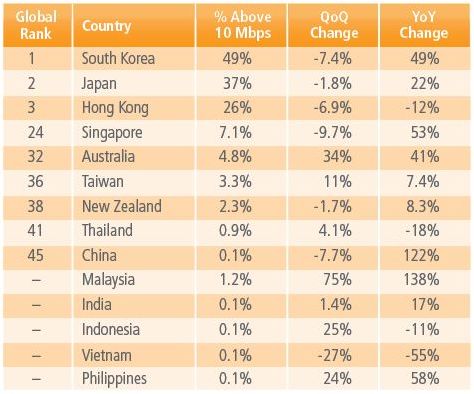Asian countries top in connection speed, attack origin

Internet speeds worldwide continue to be faster, led by Asia-Pacific countries South Korea, Japan and Hong Kong, while China remains the source of the largest amount of observed attack traffic.
According to Akamai's Second Quarter 2012 State of the Internet report released Thursday, the global average connection speed increased 13 percent to 3Mbps in the second quarter compared with the first quarter, continuing a trend of strong growth.

(Source: Akamai)
Among the countries ranked by average measured connection speed, Japan saw the largest year-over-year percentage growth at 21 percent.
This is somewhat consistent with last week's report by the International Telecommunications Union, which revealed South Korea topped the ICT Development Index (IDI) and Japan was the only other Asia-Pacific country in the top 10, coming in eighth position. The report ranked countries on their level of ICT access, use and skills.
South Korea, Japan, Hong Kong lead global pack
Consistent with Akamai's first-quarter report, South Korea, Japan and Hong Kong led in average connection speeds by country at 14.2Mbps, 10.7Mbps and 8.9Mbps, respectively.
The three Asian economies also topped the list of high broadband connectivity, defined as over 10Mbps. According to the report, 49 percent of Web connections in South Korea and 37 percent in Japan clocked above 10Mbps, while Hong Kong's figure was at 26 percent, tied at third place with Latvia.
Among Asia-Pacific markets, Singapore ranked fourth with an average measured connection speed of 5.1Mbps, putting it 25th globally, followed by Australia at 4.4Mbps and New Zealand at 3.9Mbps. Other countries that made the top 10 Asia-Pacific list included Taiwan, Thailand, Malaysia and Vietnam.
Globally, the average peak connection speed clocked at 16.1Mbps, growing 19 percent from the previous quarter and 44 percent year-on-year. Here, Hong Kong topped all countries at 49.2Mbps, beating South Korea and Japan which measured 46.9Mbps and 40.5Mbps, respectively, in average peak connection speed.
In the Asia-Pacific, Singapore again ranked fourth with an average peak connection speed of 28.3Mbps which dropped 1.1 percent over the previous quarter, but grew 36 percent compared with the same quarter last year. Taiwan ranked fifth at 24.5Mbps, followed by Australia at 21.7Mbps and Thailand at 19.1Mbps. New Zealand, Malaysia and the Philippines rounded up the top 10 list in Asia-Pacific at 16.5Mbps, 16.4Mbps and 10.9Mbps, respectively.
Most amount of attack traffic originated from Asia
That said, the greatest amount of attack traffic also originiated from the Asia-Pacific region, at 38 percent--though this was a slight drop from the previous quarter at 42 percent.
This was followed by Europe which accounted for 36 percent of attack traffic, while 23 percent originated from North and South America.
Among the countries, China also remained the single largest volume source of observed traffic at 16 percent. Taiwan and India also made the top 10 countries from where attack traffic originated at 5.4 percent and 2.9 percent, respectively.
South Korea as the original source, however, saw the most significant decrease in attack traffic among the top 10, falling from 4.3 percent in the first quarter to 2.1 percent this quarter.
Speedy on mobile
In terms of average mobile connection speeds, a Russian mobile operator delivered the fastest figure at 7.5Mbps. The highest average peak mobile connection speed came from a mobile provider in the United Kingdom, clocking at 44.4Mbps.
According to Akamai stats, in June, some 38 percent of cellular network-based mobile browser data requests came from Google Android platforms. About 33 percent came from Apple's Mobile Safari, 23 percent from Opera Mini, and about 4 percent from Blackberry.
These numbers change when all networks--and not just cellular--were considered. In this instance, Mobile Safari accounted for an average of 60 percent of requests, while Android Webkit represented 23 percent. Akamai said this data suggested Android-powered devices were used more frequently on cellular networks, while iOS devices accounted for the bulk of Wi-Fi usage.